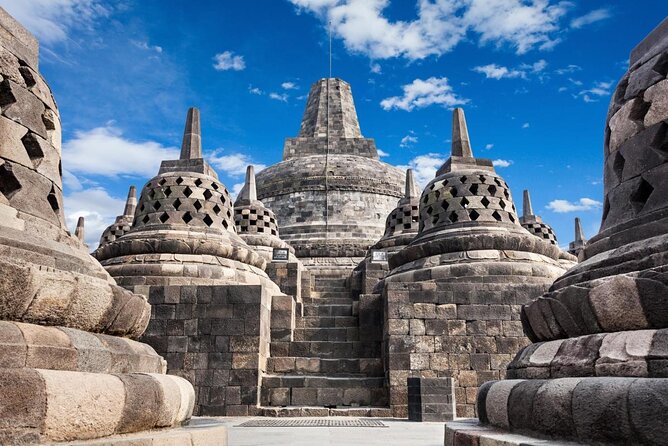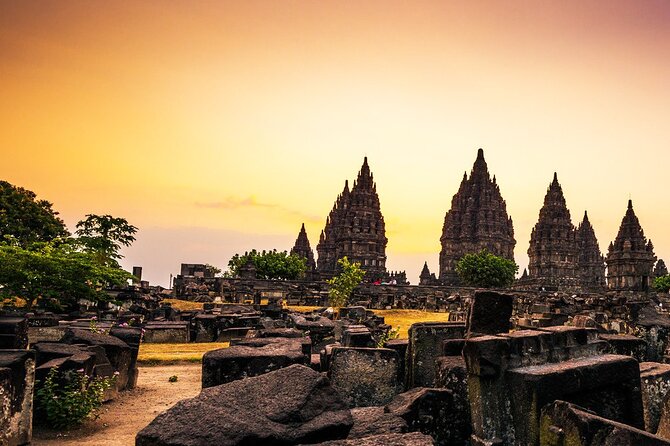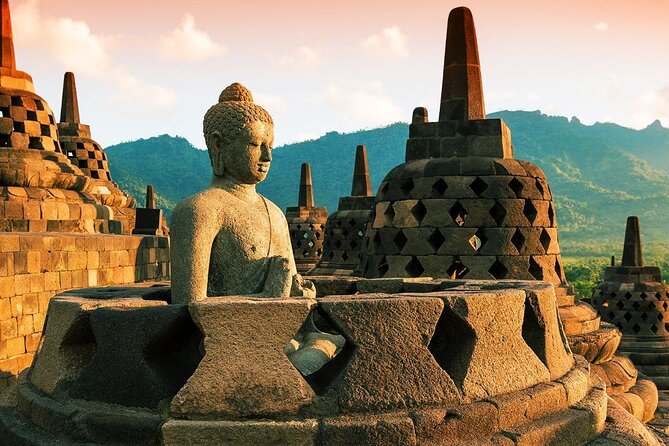Nestled in the heart of Indonesia lie the Borobudur and Prambanan Temples, two architectural masterpieces that have stood the test of time with grace and elegance. Their intricate carvings and spiritual symbolism offer a window into a bygone era, inviting visitors to ponder the mysteries that shroud these ancient structures.
As the sun sets over these awe-inspiring monuments, a sense of wonder and curiosity lingers in the air, beckoning exploration into the depths of their historical significance and cultural richness.
Good To Know

- Borobudur and Prambanan temples exemplify religious diversity and architectural excellence.
- These temples showcase intricate carvings, detailed reliefs, and sacred geometry principles.
- Cultural significance is evident in the artistic craftsmanship and spiritual symbolism of the temples.
- Preservation challenges require careful conservation efforts to safeguard these iconic cultural treasures.
Temple History and Origins

How did Borobudur and Prambanan Temples come to be significant landmarks in Indonesian history and culture?
The origins and evolution of these temples trace back to the 8th and 9th centuries when the Sailendra dynasty ruled central Java.
Borobudur, a Mahayana Buddhist temple, was constructed around 800 AD, while Prambanan, a Hindu temple dedicated to the Trimurti, was built shortly after.
These temples not only showcase the religious diversity of the region but also reflect the architectural and artistic achievements of the time.
Their historical significance lies in their roles as centers of worship, pilgrimage, and cultural exchange, attracting devotees and scholars from far and wide.
Today, they stand as enduring testaments to Indonesia’s rich heritage and spiritual traditions.
Find more activities and experiences we've covered in Jakarta.
Architectural Marvels and Designs

Exploring the architectural marvels and intricate designs of Borobudur and Prambanan Temples reveals a captivating blend of religious symbolism and ancient craftsmanship. These intricate details are a testament to the skilled artisans who dedicated themselves to creating these magnificent structures.
Here are key features that highlight the uniqueness of these temples:
Detailed Relief Carvings: The walls are adorned with intricate reliefs depicting stories from Buddhist and Hindu scriptures.
Stupas and Towers: Borobudur features numerous stupas while Prambanan boasts towering spires, representing spiritual enlightenment.
Meticulously Crafted Statues: Both temples house statues of deities and figures, showcasing the mastery of the sculptors.
Sacred Geometry: The layout and orientation of the temples follow precise geometric principles, reflecting symbolic representations in every corner.
Cultural Significance and Influence
Highlighting the profound impact on both religious and artistic realms, the Borobudur and Prambanan Temples stand as enduring testaments to cultural significance and influence. These temples, recognized for their exceptional cultural heritage and artistic craftsmanship, have captivated visitors and scholars alike for centuries. The intricate carvings and detailed reliefs found in these temples not only showcase the exceptional artistic skills of the ancient builders but also reflect the deep spiritual and cultural beliefs of the civilizations that constructed them. The cultural significance of these temples extends beyond their physical structures, influencing various aspects of society, art, and architecture. The enduring legacy of Borobudur and Prambanan continues to inspire awe and admiration, reinforcing their status as iconic symbols of cultural heritage and artistic excellence.
| Cultural Significance and Influence | |
|---|---|
| Aspect | Description |
| Cultural Heritage | Rich historical and spiritual significance |
| Artistic Craftsmanship | Exquisite carvings and architectural details |
Religious Symbolism and Practices
The religious symbolism and practices observed at the Borobudur and Prambanan Temples offer profound insights into ancient beliefs and rituals.
Symbolism Exploration:
Borobudur: The intricate carvings on the walls depict stories from Buddhist texts, symbolizing the journey towards enlightenment.
Prambanan: The towering structures dedicated to Hindu deities like Shiva, Vishnu, and Brahma symbolize the cosmic order and the cycle of creation, preservation, and destruction.
Ritual Practices:
Borobudur: Pilgrims traditionally walk around the temple in a clockwise direction, symbolizing the path to enlightenment.
Prambanan: Devotees participate in ceremonies and offerings to honor the deities and seek blessings for various aspects of life.
Preservation Efforts and Challenges
Preservation of the Borobudur and Prambanan Temples poses significant challenges due to the complex nature of the structures and the ongoing need for conservation efforts amidst environmental factors and tourism impact. Challenges include structural deterioration caused by weathering, pollution, and seismic activity.
Efforts to conserve these UNESCO World Heritage sites involve a delicate balance between restoration and preservation to maintain their authenticity. Conservation initiatives face financial constraints, lack of skilled manpower, and the need for sustainable long-term maintenance plans.
Tourism presents both opportunities and challenges, with visitor numbers needing to be managed to prevent overcrowding and minimize wear and tear on the ancient temples. Despite these obstacles, dedicated conservation teams continue to work tirelessly to safeguard these cultural treasures for future generations.
Comparison With Other World Temples
Comparing Borobudur and Prambanan Temples with other world temples reveals their unique architectural grandeur and historical significance.
Symbolism: Borobudur represents the Buddhist cosmology, while Prambanan is a masterpiece of Hindu architecture.
Architecture: Borobudur’s massive stupa structure contrasts with Prambanan’s towering spires and intricate reliefs.
Preservation Efforts: Both temples face challenges in maintaining their original splendor due to environmental factors and tourism.
Historical Significance: Borobudur, built in the 9th century, and Prambanan, constructed in the 10th century, showcase the rich cultural heritage of Indonesia.
Visitor Experiences and Testimonials
Visitors to Borobudur and Prambanan Temples often share captivating accounts of their awe-inspiring encounters with these ancient architectural wonders. Traveler reviews highlight the unique experiences and insights gained from exploring these remarkable sites. The table below provides an overview of the temple reviews from Viator and Tripadvisor, showcasing the overall ratings and distribution of feedback based on visitor experiences.
| Temple Reviews | Count & Rating |
|---|---|
| Total Reviews | 500 |
| 5-star Reviews | 380 |
| 4-star Reviews | 90 |
| 3-star Reviews | 20 |
| 2-star Reviews | 10 |
One specific review example that stands out is ‘Stunning temple complex’ by Miles_T in January 2024, reflecting the profound impact these temples have on visitors. Travelers consistently express admiration for the historical significance and grandeur of Borobudur and Prambanan Temples.
Tips for Planning Your Visit
When planning your visit to Borobudur and Prambanan Temples, ensure to check the operating hours and consider booking tickets in advance to optimize your experience. Here are some planning tips and visitor recommendations to make the most of your trip:
Guided Tours: Consider hiring a local guide to enhance your understanding of the temples’ history and significance.
Sunrise/Sunset Visits: Experience the magical sunrise or sunset views at the temples for a memorable experience.
Proper Attire: Wear modest clothing out of respect for the sacredness of the temples.
Hydration and Snacks: Carry water and snacks as exploring the vast temple complexes can be tiring.
Common Questions
Can Visitors Participate in Any Special Ceremonies or Rituals at Borobudur and Prambanan Temples?
Visitors can engage in special ceremonies and rituals at Borobudur and Prambanan temples to partake in ceremonial traditions and spiritual practices. These opportunities provide unique cultural experiences, enhancing visitors’ understanding of the temples’ significance.
Are There Any Lesser-Known Facts or Legends Associated With These Temples That Are Not Commonly Mentioned in Guidebooks?
Legends and mysteries surrounding Borobudur and Prambanan temples captivate visitors. Lesser-known facts add intrigue to these ancient wonders. Guidebooks often overlook these hidden stories, enriching the visitor experience with tales of the past.
What Are Some of the Unique Flora and Fauna That Can Be Found in the Surrounding Areas of Borobudur and Prambanan Temples?
Unique biodiversity surrounds Borobudur and Prambanan temples, boasting a variety of flora and fauna. Visitors can encounter rare species like Javan lutung monkeys, orchids, and Javan hawk-eagles. The area’s rich wildlife enhances the enchanting temple experience.
How Do the Local Communities Benefit From the Tourism Generated by These Temples, and What Initiatives Are in Place to Support Them?
Local communities benefit from tourism through increased job opportunities and economic growth. Initiatives focus on sustainable development, cultural preservation, and community empowerment. Projects include vocational training, heritage conservation, and local entrepreneurship to support residents.
Are There Any Ongoing Research Projects or Archaeological Discoveries That Are Shedding New Light on the History of These Temples?
Ongoing research projects and archaeological discoveries continue to shed new light on the history of these temples. Excavations, studies, and technological advancements contribute to unraveling the mysteries surrounding Borobudur and Prambanan, enhancing our understanding of their significance.
The Sum Up
To sum it up, the Borobudur and Prambanan Temples stand as magnificent testaments to Indonesia’s rich cultural heritage and spiritual traditions. Their intricate designs, religious symbolism, and historical significance continue to awe and inspire visitors from around the world.
Through ongoing preservation efforts and the shared experiences of those who visit, these ancient marvels will undoubtedly continue to captivate and enchant for generations to come.
More Tour Reviews in Jakarta
- Jakarta Private City Tour With Obama School Visit
- Jakarta Half Day Heritage Tour of Old Batavia
- From Port Tanjung Priok : Jakarta Explore
- Jakarta Tour :Beautiful Miniature Glorious Park of Indonesia
- Jakarta Heritage City Tour With Lunch & Souvenir
- Jakarta Night Tour : Landmarks and Street Food Experience
Looking for something different? Other Jakarta activities we've written about
- 2 Best 3 Day Tours In Jakarta
- 6 Best Workshops And Classes In Jakarta
- 3 Best Spa And Hot Springs Experiences In Jakarta
- 11 Best Historical Tours In Jakarta
- 25 Best Tours In Jakarta
- 2 Best 2 Day Tours In Jakarta
- 2 Best Shopping Tours In Jakarta
- 19 Best Airport Transfers In Jakarta
- 20 Best Private Driver Services In Jakarta
- 6 Best Full-Day Tours In Jakarta
- Best 3 Hour Tours and Experiences in Jakarta
- 19 Best Guided Tours In Jakarta
